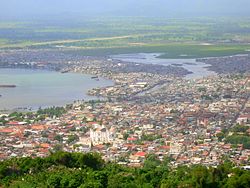Cap-Haïtien
Cap-Haïtien | |
|---|---|
 | |
| Country | Haiti |
| Department | Nord |
| Government | |
| • Mayor | Michel St Croix |
| Population (2003) | |
| • Metro | 111,094 |
| Time zone | UTC-5 (Eastern) |
| • Summer (DST) | UTC-4 (Eastern) |
| Sister cities[1] |
|---|




Cap-Haïtien (Okap or Kapayisyen in Kréyòl) is a city of about 130,000 people on the north coast of Haiti. It is the capital of the Nord department. Founded during French colonial rule, the city was originally named Cap-Français. It adopted its present name following the country's independence in 1804.
Due to its proximity to wide Caribbean beaches to its northwest, Cap-Haïtien has traditionally been a resort and vacation destination for Haïti's upper classes comparable to that of Pétionville. Recently, Cap-Haïtien has enjoyed a recent increase in tourist activity due to the rather unstable political situation in the capital Port-au-Prince.
The central area of the city is located between the Bay of Cap-Haïtien to the east, and nearby mountainsides to the west, which are increasingly dominated by flimsy urban slums. The streets are generally narrow and arranged in grids. As a legacy of the U.S. occupation of Haïti from 1915-1934, Cap-Haïtien's north-south streets were renamed as single letters (beginning with Rue A, a major avenue), and its east-west streets with numbers. This system breaks down outside of the central city, which is itself dominated by numerous markets, churches, and low-rise apartment buildings (3-4 floors each) constructed primarily before and during the U.S. occupation. Many such buildings have balconies on the upper floors which overlook the narrow streets below, creating an intimate communal atmosphere during the Haitian dinner hours.
Cap-Haïtien is also the nearest sizeable city to the historic Haïtian town of Milot, which lies 12 miles to the southeast along a gravel road. Milot was Haïti's former capital under the self-proclaimed King Henri Christophe, who ascended to power in 1807, three years after Haïti had gained independence from France. As a result, Milot hosts the ruins of the Sans-Souci Palace, wrecked by a 19th-century earthquake, as well as the Citadelle Laferrière, a massive stone fortress bristling with cannons. The Citadelle is located five miles from Milot, atop a nearby mountain. On clear days, its silhouette is visible from Cap-Haitien.
In general, the grinding poverty combined with instability caused by several coups and rebellions since 1991 have sharply curtailed the number of foreign visitors to Cap-Haïtien compared to what its tourist levels had been. Nevertheless, Cap-Haïtien is rather more stable than Port-au-Prince and so currently receives higher levels of tourism.
The small Cap-Haïtien airport, located on the southeast edge of the city, is currently served by several small domestic airlines, and is patrolled by Chilean UN troops. International service to Ft. Lauderdale, Florida is provided five days per week by Lynx Air International. The city hosts several hundred UN personnel as part of the ongoing United Nations Stabilization Mission in Haiti (MINUSTAH).
Cap-Haïtien's distance from Haïti's capital, Port-au-Prince, combined with the dire condition of Haïti's transportation infrastructure, has often made Cap-Haïtien an incubator for revolutionary or anti-government figures. In February 2004, the city was taken over by militants opposed to the rule of Haïtian president Jean-Bertrand Aristide, presaging Aristide's eventual exile from power.
The walled Labadie beach resort compound is located six miles to the city's northwest, and has served as a brief stopover for Royal Caribbean cruise ships. Today, major Royal Caribbean Cruise ships, including the largest and most luxurious (Freedom of the Seas), dock weekly at Labadie, and plans are in the making for additional stopovers in Fort-Liberté, and Jacmel. The resort is connected to Cap-Haïtien by a mountainous dirt and gravel road.
Media
Radio
- Radio Atlantik, 92.5 FM [www.atlantikhaiti.com]
- Radio 4VEH, [1]
- Radio Cap-Haitien
- Radio Citadelle
- Radio Etincelle
- Radio Gama
- Radio Méga,103.7 FM
- Radio Sans Souci
- Radio Venus FM
- Voix de l’Ave Maria
- Voix Du Nord
- Radio Paradis
- Radio Nirvana, 97.3 FM [www.radionirvanafm.com]
- Radio Hispaniola
- Radio Passion Haiti [2]
Television
- Radio Tele Venus
- Radio Tele Paradis
- Chaine 6
- Television Nationale d'Haiti
- Chaine 7
Major Schools
- Frères de l'Instruction Chrétienne (F.I.C)
- Collège Notre-Dame du Perpétuel Secours (C.N.D.P.S)
- Collège Saint-Joseph de Cluny
- Collège Reggina Asumpta (C.R.A)
- Collège L'Essor (C.E)
- Collège Matin Luther King (C.M.L.K)
- Collège Pratique Du Nord (C.P.N)
- Centre de Formation Classique (C.F.C)
- collège Jean-Claude Mondésir (C.J.C.M)
- Collège du Christ-Roi (C.C.R)
Vertieres
Vertieres, located near Cap-Haitien, is the site of the Battle of Vertières - the last and defining battle of the Haitian Revolution. On November 18, 1803, Haitian rebels led by Jean-Jacques Dessalines defeated a French colonial army led by the Comte de Rochambeau, leading to the independence of Haiti.
External links
- short article - Columbia encyclopedia
- The Louverture Project: Cap Haïtien - Article from Haitian history wiki.
